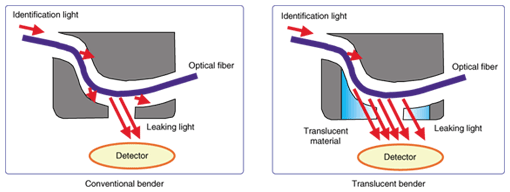 |
|||||||
|
|
|||||||
|
Letters Vol. 6, No. 5, pp. 24–27, May 2008. https://doi.org/10.53829/ntr200805le1 Fiber Identifier for Bend-insensitive Optical FibersAbstractWe have developed an optical fiber identifier for bend-insensitive R15 fibers. These bendable fibers are being widely installed, especially in drop areas, but it is difficult to identify a specific R15 fiber in a fiber bundle when the conventional fiber identifier is used. Our new identifier ensures correct fiber identification with high sensitivity and low insertion loss.
1. Optical fiber identification techniqueThe optical subscriber network is expanding rapidly in today's broadband communication society and a lot of installation and maintenance work is currently being undertaken. It is becoming increasingly important to prevent incorrect cutting and/or connection of an optical fiber during such work. Field engineers use a fiber identification technique to identify a specific fiber in a fiber bundle [1]. The technique is based on the macro-bending method, as shown in Fig. 1. An identification light modulated at a certain frequency is launched into a selected fiber at a central office. At the worksite, the engineer selects likely fibers in a bundle and tests them one by one using a fiber identification tool (optical fiber identifier) [2] until the right one has been found. The fiber is clamped in the optical fiber identifier and bent. The identifier selectively detects the modulated identification signal radiating from the bent fiber. When the identification signal is detected from a certain fiber, the engineer knows that he or she has found the end of the fiber selected at the central office. The identification light has a different wavelength from the communication light used for carrying data to enable in-service fiber identification without interrupting the service provided to the customer.
2. R15 fiber identification issuesOptical fiber cables containing bend-insensitive R15 fiber are widely installed as drop or aerial cables. This bendable fiber is easier to install than conventional fiber because it can be bent tightly with almost no communication light leaking out. On the other hand, these low-bending-loss characteristics mean that the conventional fiber identifier has trouble identifying R15 fibers. 3. New identifier for R15 fibersTo solve this problem, we have developed a new identifier that can function even when little light leaks out of the fiber. It has three features: low production cost, low insertion loss equivalent to that of the conventional identifier, and improved sensitivity. The low fabrication cost is achieved through modular design. To test R15 fibers, a field engineer can use an existing identifier and simply exchange the bending part (bender). A sufficient number of suitable identifiers are already available at locations throughout Japan. Therefore, we developed only a new bender instead of redesigning the entire identifier. Once an identifier has been modified, it can thereafter be used for both conventional and R15 fibers: there is no need to switch back and forth between the new and old benders. An overview of the identifier and a magnified view of the bender are shown in Fig. 2.
One idea for identifying the R15 fiber is to bend the fiber with a tighter radius of curvature in order to cause more light to leak out. However, this would increase the insertion loss and might affect the communication light. Instead, we achieved a low insertion loss and improved sensitivity by designing a translucent bender with the same shape as the conventional bender. This can detect the weak light leaking from an R15 fiber. The shapes of the conventional bender and the new translucent bender are shown in Fig. 3.
4. Translucent benderThe translucent bender uses two techniques. These lead the leaking light into the translucent material and help the propagating identification light to reach the photodetector. The path of the identification light leaking from the optical fiber is shown in Fig. 4. The light inside the core propagates to the coating layer via the cladding. In the conventional bender without translucent material, some of the light is reflected at the interface because the coating layer has a higher refractive index than air. On the other hand, in the new bender, the light can propagate into the resin in a straight line at the interface between the coating layer and the translucent resin because the refractive indexes of these two layers are almost the same. In addition, the high transmittance of the translucent resin prevents the leaking light from attenuating until it reaches the interface with the air. There is some unevenness on the surface, which disperses the light from the fiber. This means the leaking light gets closer to the detector before it disperses. As a result, the weak light leaking from a bend-insensitive R15 fiber can be detected.
5. ConclusionWe have successfully developed a bender that enables existing optical fiber identifiers to handle bend-insensitive fiber. The key improvement is the use of a translucent resin for the fiber guide. It has high transmittance and a refractive index that is nearly the same as that of the optical fiber coating layer. These characteristics enable it to lead the leaking identification light to the detector. Identifiers upgraded with this new bender should reduce the rate of fiber misidentification and thus reduce maintenance work and improve services to customers. References
|
|||||||














